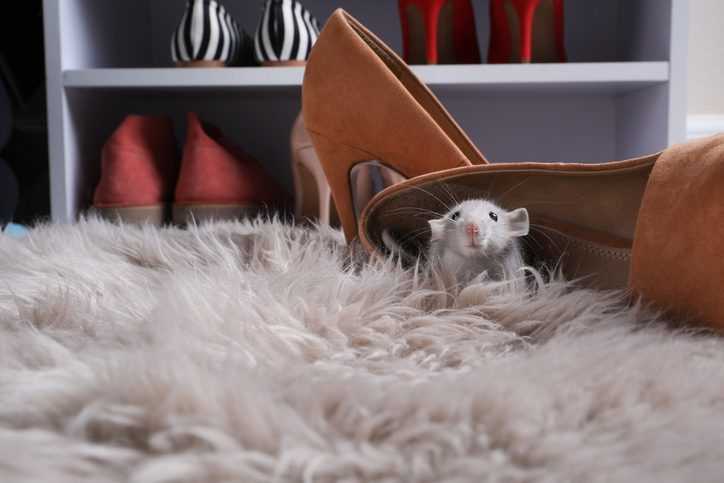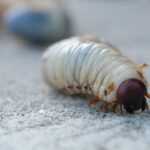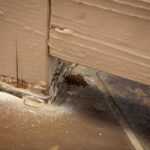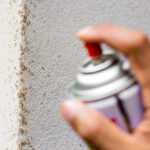It is never a delightful sight to see that your favorite shirt was chewed up by a mouse. While mice primarily consume seeds and grains, they are known to chew on clothing made from natural fibers, leading to the misconception that mice eat clothes. Being proactive at keeping mice out of your home can be tricky, but there are ways to prevent it from happening. If you have been unlucky enough to face a mouse one-on-one or are looking for ways to avoid this from happening, PURCOR offers rodent control solutions for this very reason, and wants to share ways that you can keep a sneaky little mouse far from your beloved wardrobe.
Understanding Mice Behavior
Mice are intelligent and adaptable creatures that can thrive in various environments. Primarily nocturnal, these little critters are most active at night, using their strong sense of smell and hearing to navigate and find food. Mice are social animals, often living in groups led by a dominant male. Understanding their behavior is crucial in preventing and controlling mouse infestations.
Mice are drawn to food, shelter, and warmth, which is why they often make their way into homes and buildings. They are skilled climbers and can squeeze through tiny openings, making them difficult to detect and eliminate. Additionally, mice are prolific breeders, with females capable of producing up to 12 litters per year, each containing 3-12 young. This rapid reproduction rate can quickly turn a small mouse problem into a full-blown infestation if not addressed promptly.
Why do certain things attract mice to my home?
The first way to keep mice out is to know why they want in. The two common types of mice you will find in your Pacific Northwest home are deer mice and house mice. Regardless of which type invades your home, you can count on these nibbling pests to target your wardrobe.
If you find holes in your clothes, you may assume mice are eating them. However, mice actually gnaw off pieces of clothing for their nests. Before you enjoy a sigh of relief that mice aren’t eating your clothes, brace yourself: gathering nesting materials means mice are preparing to have babies.
What’s the difference between deer mice and house mice?
If you do spot a mouse in your home, it’s important to understand the differences between house mice and deer mice. Wild mice, in contrast, have a varied diet and can consume a broader range of food sources depending on their natural habitat. While any finding any type of mouse indoors is cause for concern, the species you find does matter.
Deer mice prefer the outdoors, but occasionally creep into homes for shelter and food during the winter. House mice, however, are determined to share your living space with you all year long.
What Attracts Mice to Your Home
Mice are always on the lookout for food, shelter, and warmth, making homes an ideal target. Here are some common attractants that might be inviting these unwelcome guests:
- Pet Food: Mice are attracted to pet food, especially if it’s left out in the open or stored in easily accessible containers. Always store pet food in sealed containers and clean up any spills promptly.
- Food Debris: Crumbs, spills, and other food debris can attract mice, especially if they’re not cleaned up promptly. Regularly clean your kitchen and dining areas to minimize these attractants.
- Clutter: Mice love to nest in cluttered areas like attics, basements, and garages. Keep these areas organized and free of unnecessary items to deter mice from making themselves at home.
- Moisture: Mice need water to survive and are often attracted to homes with leaky pipes, clogged drains, or high humidity. Fix any leaks and use dehumidifiers in damp areas to reduce moisture levels.
- Warmth: Mice are drawn to warm and cozy areas, such as near heating vents, fireplaces, or drafty windows. Ensure your home is well-insulated and seal any drafts to keep mice out.
By addressing these common attractants, you can make your home less appealing to mice and reduce the risk of an infestation.
Why Mice Infest Wardrobes
Wardrobes offer mice a warm, cozy, and secluded space to nest and breed, making them an attractive target. Mice are particularly drawn to the natural fibers found in clothing, such as cotton, wool, and silk, which they use to build their nests. Additionally, food and moisture found in wardrobes, such as crumbs, spills, or damp clothing, can further entice these pests.
To prevent mice from infesting your wardrobe, it’s essential to store clothing in airtight plastic containers or bins. These containers are difficult for mice to chew through and help keep your clothes safe. Keep the floor clear of clutter and regularly clean and declutter the area to make it less inviting for mice. By taking these steps, you can protect your wardrobe from becoming a mouse haven.
How can I keep mice away?
In addition to limiting mice’s access to food and sealing potential entryways around your home, review how you currently store your clothing. Do you keep it on hangers, or in a dresser? While convenient and more aesthetically pleasing, hanging your clothes or folding them for a dresser makes them a mousy free-for-all. Organic materials and food debris can attract pests, so ensure you wash clothes before storage to deter infestations. Learn how you can prevent mice from taking a bite out of your clothing with PURCOR.
Mice may be attracted to pet food due to humans sometimes being less cautious about storing pet food securely compared to their own food. This makes pet supplies a target for mice, especially when food is left exposed.
Seal Entry Points into Your Home
Mice can squeeze through tiny openings, making it essential to seal all entry points into your home. Here are some common entry points to watch out for:
- Cracks and Crevices: Mice can fit through openings as small as 1/4 inch, so it’s essential to seal all cracks and crevices around windows, doors, and pipes. Use caulk or expanding foam to block these openings.
- Vents: Mice can enter homes through vents, such as dryer vents, bathroom vents, and attic vents. Install vent covers or screens to prevent mice from getting in.
- Chimneys: Mice can climb up chimneys and enter homes through the chimney flue. Install a chimney cap to keep mice and other pests out.
- Pipes: Mice can enter homes through pipes, especially if they’re not properly sealed. Use steel wool or caulk to seal gaps around pipes.
Additionally, install door sweeps or weatherstripping around doors and windows to prevent mice from entering. By sealing these entry points, you can significantly reduce the chances of a mouse infestation.
Use Proper Clothing Storage
Instead of keeping your clothes on hangers or in a dresser, store them in airtight plastic containers to prevent a rodent infestation. Unlike dressers, which have mouse-sized spaces (and often made of flimsy plywood), plastic containers are difficult for mice to chew through.
Don’t have enough space in your closet for all your clothes? Remember to keep seasonal storage in hard plastic containers as well. Mice can easily bite through clothing bags or cardboard boxes.
Keep Clothing off the Floor
Resist the urge to leave clothes on the floor or sitting in your hamper for long periods of time. Field mice are omnivores and eat insects, which can indicate an underlying insect infestation. If mice find quiet, undisturbed piles of clothing, they may treat last week’s dirty laundry as home sweet home for their young. Always place clothes in the hamper, and take care of laundry at least once or twice a week.
Watch for Signs of Mice around Your Home
You’re more likely to see signs of a mouse infestation before you see the critters themselves. Finding chewed clothes, for example, is a strong indication of a mouse infestation. Mice eat a variety of foods, so you might also notice gnawed food packages. Other signs of a mouse problem in your home include:
- Gnaw marks on wooden furniture
- Dark pellet-like droppings around baseboards
- Tracks or shiny rub marks on walls from mice’s oily fur
- Scratching noises in walls or ceilings
Identifying Mice Infestation
Identifying a mouse infestation can be challenging, but there are some common signs to look out for:
- Droppings: Mice leave behind small, dark droppings that are often found in areas where they frequent, such as near food sources or nesting sites.
- Gnaw Marks: Mice gnaw on surfaces, especially wood, to create holes and pathways. Look for gnaw marks on furniture, baseboards, and other wooden structures.
- Footprints: Mice leave behind small footprints, especially in dusty areas. You may also notice tail drag marks alongside the footprints.
- Nests: Mice build nests using natural fibers, such as cotton, wool, and silk. Check for nests in hidden or secluded areas, such as behind appliances or in storage boxes.
- Sounds: Mice make scratching and scurrying sounds, especially at night. Listen for these noises in walls, ceilings, and other areas where mice may be hiding.
If you suspect a mouse infestation, it’s essential to act fast and contact a pest control professional to eliminate the problem. Early detection and intervention can prevent a small mouse problem from turning into a full-blown infestation.
Why Mice Infestation is Dangerous
Aside from the nuisance of your clothing being chewed on, mice carry diseases that can contaminate your food. While mice eat grass occasionally, it is not their primary food choice due to its low caloric value and difficult digestibility. You may be able to catch a little mouse on your own, but the best thing you can do is hire professional pest control so that it does not turn into an expensive infestation. They also carry ectoparasites like fleas, ticks, and mites.
Invest in Pest Control Services
Properly storing clothes helps prevent mice’s access to your wardrobe, but it takes a professional to safeguard your home against these whiskered-pests. At PURCOR, our team of specialists use targeted, innovative pest control solutions designed to control and prevent mouse infestations.
After we’ve solved your mouse issue, we can also assist in preventing mice and other rodents from finding their way into your home again. By mouse-proofing your wardrobe and relying on our team, you can enjoy the peace of mind of having nibble-free clothes.
Request Your Free Mouse Control Estimate from PURCOR
Ready to send mice packing and prevent a rodent infestation? Choose a professional rodent control service you can count on; Choose PURCOR. In addition to effective mouse control and prevention, our solutions are environmentally conscious to protect you, your family, and your home. Request your free estimate online today or give us a call to learn more!
"*" indicates required fields
"*" indicates required fields




